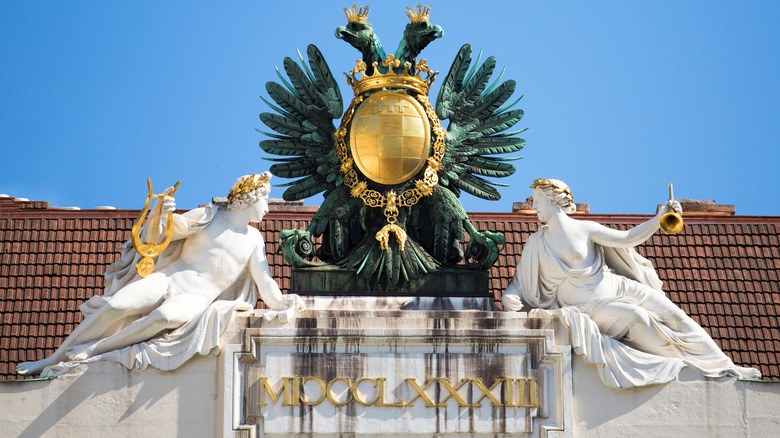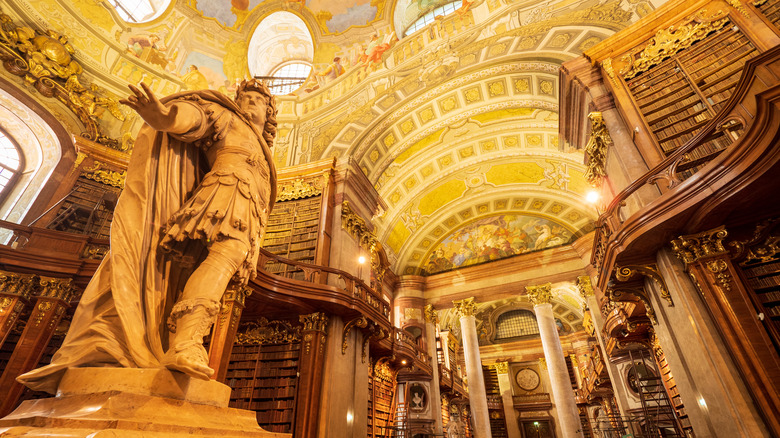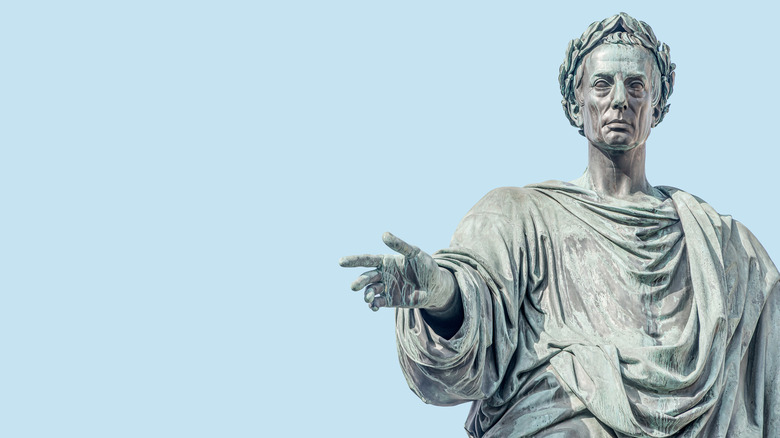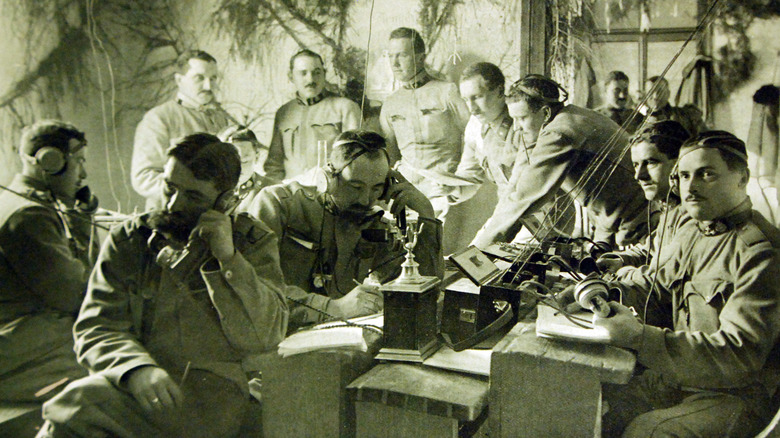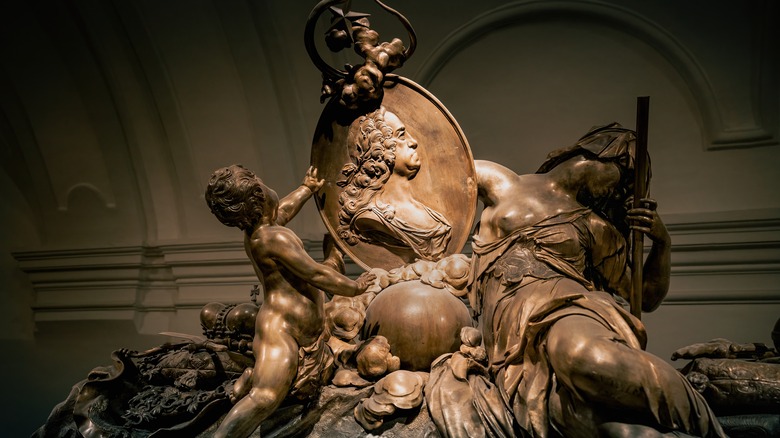A Brief History Of The Habsburgs, Europe's Forgotten Empire
Nowadays the word "Habsburg" might evoke nothing more than images of a supremely protuberant chin shared between inbred royalty. While accurate, this certainly isn't all there was to the now-extinct Habsburgs and their once Europe-dominating empire. With a lineage spanning back to Guntram the Rich in 10th-century Switzerland, the Habsburg family came to power in 1267 under the leadership of Rudolf I, claimed the mantle of the Holy Roman Empire, and for 650 years dominated practically all of central and eastern Europe (via World of the Habsburgs).
Throughout the centuries, the Habsburgs accumulated bits of land and power over a wide expanse of ethnic groups and borderlines. By the time the Habsburg-led Empire of Austria joined with Hungary to become the Austro-Hungary Empire in 1867 leading up to World War I in 1914, Germans, Hungarians, Czechs, Slovaks, Poles, Ukrainians, Slovenes, Croats, Serbians, Romanians, Italians, and more were smeared within regions of German Austria, Bohemia, Transylvania, Moravia, Galicia, Slovakia, Hungary, Croatia, Trentino, and many others (as Brilliant Maps shows). Some of these ethnic groups lived in neighboring Serbia, Bulgaria, Romania, Russia, and Germany, which forced people of shared heritage to fight and kill each other during World War I.
The ramifications of Habsburg rule continue to the present. On one hand, the empire's multiculturalism and ethnic disparity produced a disassembled mess with no shared identity. On the other hand, as The New York Times discusses, the Habsburgs' attempts at surprisingly progressive state-building relate critical lessons about our own time.
Origins of an empire
Habsburg rule began over 700 years before Europe's current, exceptionally polite and cooperative nations, but has roots in the demise of the Roman Empire. In A.D. 285, Emperor Diocletian split the fading empire into two halves — east and west — in an attempt to keep Rome on life support, as World History describes. It worked, to a degree, but come 476 CE the western part crumbled into bits of nobility-owned land that eventually became France, Germany, Spain, etc. The eastern half lived on with its capital in Constantinople (modern-day Istanbul), and would become the Holy Roman Empire.
The Holy Roman Empire was, essentially, a seat-less, country-less nation. It was a confederacy of loose kingdoms, powerful families, and shifting power alliances held together by a dual power structure of pope (spiritual leader) and emperor (secular leader), via World History. The empire officially lasted from A.D. 962 to 1806, and its first emperor was none other than the pious, Rome-aphile and illiterate Frankish king, Charlemagne. It's simply the case that Charlemagne's family was the "first among equals," so to speak, out of a bunch of regional rulers.
Come A.D. 1273, the crown passed to Rudolf of Habsburg following military conquests and a pope-arranged election, as World of the Habsburgs explains. Rudolf, from a line of Swiss nobility spanning back to the late 10th century, became the first of a dynasty of de facto Roman emperors that lasted until the Holy Roman Empire finally died in 1806.
Loosely-defined power
Even though the Habsburgs took over Charlemagne's throne in A.D. 1273, they weren't the official heads of the Holy Roman Empire until 1415 (via World History). And even then, the leader of their dynasty wasn't given the title "Holy Roman Emperor" until Frederick III in 1453 (via Visiting Vienna). On top of this, there was no formal, legal Habsburg "empire" until 1804. Until then, the family simply accumulated power, rather quietly and often through arranged marriages, that tied central and eastern Europe to the Habsburg family and its regionally-controlled administrative branches in Vienna. This also means that there is some territorial overlap, and disparity, between the lands under Habsburg "control," and those belonging to the Holy Roman Empire that it came to lead.
And so we see the reason for some of the general confusion and lack of knowledge regarding the Habsburg empire. The period doesn't, for us in the present, contain big and recognizable features that help clarify our vision of the age, like Roman legionnaires. Throughout the Middle Ages, the balance of power in Europe rested on an assemblage of duchies and nobility, guilds and mercantile powers, and the church. The Habsburgs were fine just letting it all be.
The Habsburg's subtle methods resulted in a stretch of power that reached, at maximum, all the way from modern-day Belgium in the west to modern-day Ukraine in the east. That's almost the entirety of central through eastern Europe.
Dual-monarchy rule
We have none other than Napoleon Bonaparte to thank for the formal founding of the Empire of Austria. After coming to power during the French Revolution (1789 – 1799), Napoleon declared himself emperor of France in 1804 (via History). In reaction, Habsburg head Franz II looked around and said, "Sure, I might as well do the same." As World of the Habsburgs explains, he declared the hereditary Habsburg lands the "Empire of Austria" that same year. As a result, Franz II shifted power away from his Holy Roman Empire crown. Two years later in 1806, under pressure from Napoleon, the Habsburg-led Holy Roman Empire was dissolved.
The Empire of Austria existed for a mere 63 years. Along the way, come 1848, France went through another revolution (this happened a lot) dubbed the February Revolution. This time, as Live Science explains, they overthrew their monarchy and instituting "The Second Republic." As Visiting Vienna says, folks in Europe were inspired. There were some uprisings across the continent, and to make a long story short, Austrian Emperor Franz Joseph I brokered a deal in 1867 to incorporate the Kingdom of Hungary into his empire in a dual-monarchy structure: different governments, foreigners in each other's lands, but one empire.
By this time, the fledgling Austro-Hungarian Empire was a complete mixture of dozens of languages, ethnic groups, cultural heritages, and more. And yet, by the early 20th century, a single identity started to cohere. Then World War I happened.
The death knell of trenches and mortars
World War I was the boulder that shattered Europe's spine and created the bedrock of Europe's modern-day geopolitics. The whole thing began in Austro-Hungary when Archduke Franz Ferdinand, emperor Franz Joseph I's nephew, was assassinated by a Serbian revolutionary from the south of the Austro-Hungary empire, as Facing History explains. This set off a chain reaction that left 9 million obliterated by mortar shells and machine guns, and an unreal 65 million wounded (also via Facing History). Austro-Hungary declared war on Serbia. Germany, in support, sent their army through neutral Belgium, and England declared war on Germany. Germany then declared war on France, Britain's ally, and later Italy, Russia and more joined.
World War I raged from 1914 to 1918, with Austro-Hungary — the old Habsburg empire — as one of its key players. By the time the war wound to a close, map lines across the entire European continent got redrawn, as Vox illustrates. The Treaty of Versailles, signed June 28, 1919, broke Austro-Hungary into a bunch of smaller countries, including Austria, Poland, Czechoslovakia, Hungary, Romania, Yugoslavia, and more. Russia had undergone its communist revolution during the war, as well — the Vladimir Lenin-led Bolshevik Revolution — which created more countries at the same time, like Finland, Estonia, Latvia, and Lithuania.
Few of these countries synced with regional ethnic groups, which had disastrous consequences throughout the rest of the 20th century. The Habsburg's empire was dead, but their legacy was not.
Broken remnants reformed
The death of the Habsburg empire affected three countries more than others: Hungary, Czechoslovakia, and Yugoslavia. Hungary lost two-thirds of its land in the Treaty of Trianon, per the BBC. Czechoslovakia fell under Nazi control during World War II from 1938 to 1945, and Soviet control from 1948 all the way to 1989, as Britannica explains. Miraculously, as the Soviet Union waned, Czechoslovakia peacefully split into two countries, the modern-day Czech Republic and Slovakia.
Yugoslavia came to a far bloodier fate, as the BBC describes. They also fell under Soviet influence, but when the U.S.S.R. fell, the Balkan Wars pit the Bosnian Serb Republican against the Muslim Croat Republic (1991-1999). 100,000 people died in ethnic cleansings, and over a million were displaced from their homes. In the end, Yugoslavia splintered into Slovenia, Croatia, Serbia, Bosnia & Herzegovina, Montenegro, and Macedonia. Only as recently as 2008 did Kosovo break off from Serbia to form its own country, via the US Department of State. Vojvodina, a Serbian province, faces a similar future.
Every single one of these countries' fates, and all their people, can be traced back to the Habsburgs over 700 years ago. The unification of the past yielded the deaths of the present, within ethnically muddled borders of people forced to live together. And while the Habsburg family itself can't be blamed for any negative consequences of their relatively benign reign, it's important for all us to take note of the lessons they left behind.

